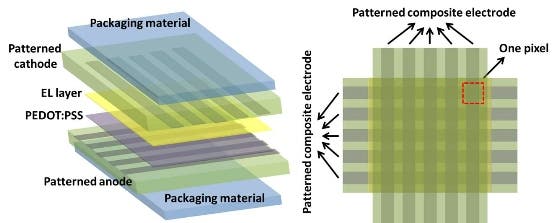Take a moment to imagine a phone display as clear as a window, a curtain that can illuminate a room, and a smart phone that can stretch like rubber; now imagine all these things are made from the same material.
Researchers from UCLA’s Henry Samueli School of Engineering and Applied Science have developed a transparent, elastic organic light-emitting device, or OLED, which has the potential to make this happen. The OLED can be repeatedly stretched, folded and twisted, all at room temperature, without anything special, while still remaining turned on and retaining its original size and shape.
OLED technology itself is not a really new idea – it’s currently used for many smartphones and some televisions. But this new, smart OLED version from UCLA could lead to foldable and expandable screens for new classes of smartphones, as well as electronic-integrated clothing, wallpaper lighting, new minimally invasive medical tools, and many, many others.
“Our new material is the building block for fully stretchable electronics for consumer devices,” said Qibing Pei, a UCLA professor of materials science and engineering and principal investigator on the research. “Along with the development of stretchable thin-film transistors, we believe that fully stretchable interactive OLED displays that are as thin as wallpaper will be achieved in the near future. And this will give creative electronics designers new dimensions to exploit.”
In order to test their results, researchers stretched and restretched the OLED 1,000 times, extending it up to 30 percent its original size – and it still continued to work at very high efficiency. If you cut back on some efficiency, you can stretch it to double its initial size, while also folding it 180 degrees and twisting it in multiple directions. It’s also fairly easy and cheap to produce.
“The lack of suitable elastic transparent electrodes is one of the major obstacles to the fabrication of stretchable display,” Liang said. “Our new transparent, elastic composite electrode has high visual transparency, good surface electrical conductivity, high stretchability and high surface smoothness — all features essential to the fabrication of the stretchable OLED.”
They also demonstrated that such an OLED technology could feature multiple pixels, rather than just a solid block of light.
“While we perceive a bright future where information and lighting are provided in various thin, stretchable or conformable form factors, or are invisible when not needed, there are still major technical challenges,” Pei said. “This includes how to seal these materials that are otherwise sensitive to air. Researchers around the world are racing the clock tackling the obstacles. We are confident that we will get there and introduce a number of cool products along the way.”
The results were published in Nature Photonics.











